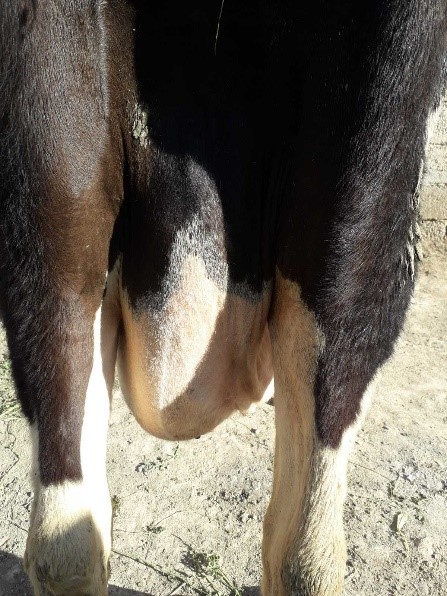Detection of Bacterial Contaminant of Newborn Calves and Their DOMS Pens
Abstract
The aim of this scientific job is to describe reasons for pathogen loading in the environment and ways to reduce this loading and determination of these pathogens . Most pathogens are opportunistic exploit the contamination of pens bed and hutches by different types of calves secretions and inflammatory exudates from the uterus and mammary gland . The large isolated pathogens were Escherichia coli and Staphylococcus aureus and one isolate represent a genus Klebsiella . The main drugs were more active against these bacteria after the sensitivity test has been done ; Enrofloxacen , Flurphenicol, Colistin Sulfate and combination of Sulfadiazine Vs Trimethoprim. Amoxicillin , Ampicillin and Tetracycline were less active.
In recommendation, good ventilation, exposure to sun light and proper disinfection of the pens will share in decrease the rate of infections when occurred through indirect contact. Sensitivity test has been applied from time to time for passing the drug resistance.
References
Bartels, C., Holzhauer M., Jorritsma R., Swart W. and Lam T. (2010). Prevalence, prediction and risk factors of enteropathogens in normal and non-normal faeces of young Dutch diary calves. Preventive Veterinary Medicine, 93, 162-169.
Berge, A.C.B., Lindeque P., Moore D.A. and Sischo W.M. (2005). A Clinical Trial Evaluating Prophylactic and Therapeutic Antibiotic Use on Health and Performance of Preweaned Calves. J. Dairy Sci. 88, 2166–2177.
Davidson, Fraser W.; Whitney Hugh G. and Tahlan Kapil (2015). "Genome Sequences of Klebsiella variicola Isolates from Dairy Animals with Bovine Mastitis from Newfoundland, Canada". Genome Announcements. 3 (5): e00938–15.
Eibl , C. , Ricardo B. , Lorenzo V. , Hugues G. , José F. , Johanna W. , Alexander T. and Alexandra H .(2021). The Antibiotic Treatment of Calf Diarrhea in Four European Countries: A Survey. Antibiotics, 10, 910.
Gould, K. ( 2014). Calf scours signs, treatment and prevention: Part 2. Michigan State University Extension and Dan Grooms, DVM, MSU College of Veterinary Medicine.
Gulliksen, S. M., Jor E., Lie K. I., Hamnes I. S., Loken, T. and Akerstedt, J. et al. (2009). Enteropathogens and risk factors for diarrhea in Norwegian dairy calves. J Dairy Sci, 92, 5057-5066.
Hammit, M. C., Bueschel, D. M., Keel, M. K., Glock, R. D., Cuneo, P. and DeYoung, D. W. et al. (2008). A possible role for Clostridium difficile in the etiology of calf enteritis. Vet Micro, 127, 343-352.
Kumar, P. , Ojasvita, Anupama Deora, Himanshu Sharma, Satbir Sharma, Dinesh Mittal, Vandna Bhanot, Anand Prakash, Rajendra Yadav and R.P. Diwakar.(2020). Bovine Mastitis: A Review. Middle-East Journal of Scientific Research 28 (6): 497-507.
MacDiarmid, S.C.(1978). Antibacterial drugs used against mastitis in cattle by the systemic route. New Zealand Veterinary Journal , Volume 26, 1978 - Issue 12,P: 290-295.
Masalha, M. , Borovok I., Schreiber R., Aharonowitz Y. and Cohen G. (2001). "Analysis of transcription of the Staphylococcus aureus aerobic class Ib and anaerobic class III ribonucleotide reductase genes in response to oxygen". Journal of Bacteriology. 183 (24): 7260–7272.
Nielsen, E. M., Tegtmeier C., Andersen H. J., Gronbaek, C. and Andersen J. S. (2002). Influence of age, sex and herd characteristics on the occurrence of Verotoxin-producing Escherichia coli O157 in Danish dairy farms. Vet Micro, 88, 245-257.
Podder, Milka P.; Rogers, Laura; Daley, Peter K.; Keefe, Greg P.; Whitney, Hugh G.and Tahlan Kapil (2014). "Klebsiella Species Associated with Bovine Mastitis in Newfoundland". PLOS ONE. 9 (9): e106518.
Podschun, R. and Ullmann U. (1998). Klebsiella spp. as nosocomial pathogens: epidemiology, taxonomy, typing methods, and pathogenicity factors. Clinical Microbiology Reviews. 11(4): 589-603.
Pyörälä S. ,( 2009) . Treatment of mastitis during lactation. Irish Veterinary Journal ,Volume 62 Supplement 40-44.
Rogers, K. (2022). Klebsiella Bacteria Genus. Encycopedia Britannica.
Russell, J.B and Jarvis G.N. (2001). "Practical mechanisms for interrupting the oral-fecal lifecycle of Escherichia coli". Journal of Molecular Microbiology and Biotechnology. 3 (2): 265–72.
Smith, G.W. (2009). Calf scour . Vet. Clin. North Am. Food Anim. Pract, 25; 55-72.
Struve ,C. and Krogfelt K. A. (2004). Pathogenic potential of environmental Klebsiella pneumoniae isolates. Environ Microbiol ; 6 (6): 584-90.
Singleton, P. (1999). Bacteria in Biology, Biotechnology and Medicine (5th ed.). Wiley. pp. 444–54.
Tenaillon, O., Skurnik D., Picard B. and Denamur E. (2010). "The population genetics of commensal Escherichia coli". Nature Reviews. Microbiology. 8 (3): 207–17.
Tong, S.Y., Davis J.S., Eichenberger E. Holland T.L. and Fowler V.G. (2015). "Staphylococcus aureus infections: epidemiology, pathophysiology, clinical manifestations, and management". Clinical Microbiology Reviews. 28 (3): 603–661.
Vogt, R.L. and Dippold L. (2005). "Escherichia coli O157:H7 outbreak associated with consumption of ground beef ". Public Health Reports. 120 (2): 174–78.
Wang, H., Sangwan, N., Li, H.-Y., Su, J.-Q., Oyang, W.-Y. and Zhang, Z.-J., et al. (2017). The antibiotic resistome of swine manure is significantly altered by association with the Musca domestica larvae gut microbiome. ISME J. 11, 100–111.
Wani, S.A.; Bhatt, M.A.; Samanta, I.; Nishikawa, Y. and Buchh, A.S. (2004). Escherichia coli O116 associated with an outbreak of calf diarrhoea. Vet Rec. 154: 506- 508.
Wray, C., Todd N., McLaren I., Beedell Y. and Rowe B. (1990a). The epidemiology of Salmonella infection of calves: the role of dealers. Epidemiol.Infect., 105, 295-305.
Zhu, Y. G., Johnson T. A., Su J. Q., Qiao M., Guo G. X. and Stedtfeld R. D., et al. (2013). Diverse and abundant antibiotic resistance genes in Chinese swine farms. Proc. Natl. Acad. Sci. U. S. A. 110, 3435–3440.
Zwald, A.G., Ruegg P.L., Kaneene J.B., Warnick L.D., Wells S.J., Fossler C.and Halbert L.W. (2004). Management Practices and Re-ported Antimicrobial Usage on Conventional and Organic Dairy Farms. J. Dairy Sci., 87, 191–201.







